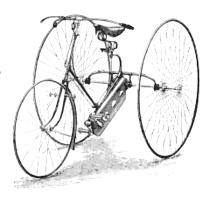
While the men were risking their necks on the high wheels, ladies, confined to their long skirts and corsets, could take a spin around the park on an adult tricycle. These machines also afforded more dignity to gentlemen such as doctors and clergymen. Many mechanical innovations now associated with the automobile were originally invented for tricycles. Rack and pinion steering, the differential, and band brakes, to name a few!
Popular during the late 1880’s.
A Brief History of the Tricycle
The first tricycle was built in 1680 for a German paraplegic named Stephan Farffler ( -Oct. 24, 1689), who lived near Nuremburg. He was a watch-maker and the tricycle had gears and hand cranks.
Two Frenchmen, named Blanchard and Maguier invented a tricycle in 1789, which prompted the Journal de Paris to coin the words bicycle and tricycle and publish them on July 27th to differentiate between the two types of machines. Denis Johnson patented a tricycle in England in 1818. A three-wheeled swiftwalker was introduced in 1819.
On November 18, 1876, James Starley introduced the Coventry Lever Tricycle, a side-driven two-track, lever-driven machine, and that started the tricycling craze in Great Britain. It had two small wheels on the right side, that both steered simultaneously. A large drive wheel was on the left side. In 1877, he introduced the Coventry Rotary, one of the first rotary chain drive tricycles.
In 1879, twenty types of tricycles and multi-wheel cycles were produced in Coventry, England, and by 1884, there were over 120 different models produced by 20 manufacturers. Tricycles were used especially by those who could not ride high wheelers, such as women who were confined in the long dresses of the day, and short or non athletic men.
From 1881 to 1886 in Great Britain, more tricycles were built than bicycles, but this was primarily a class phenomenon, since tricycles were more expensive, perceived as more genteel, and the upper classes had the disposable income to buy them for the women in the family. As a result, tricycling remained popular in Great Britain long after riders turned away from them elsewhere. They even had regular racing. By the 1990s, that was no longer true, and many British manufacturers stopped making them. In the United States, tricycles are used primarily by older persons for recreation, shopping, and exercise. In Asia and Africa, tricycles are used primarily for commercial transportation.
The tricycles produced from 1876 to 1884, of which Starley’s Coventry Rotary is the most famous example, are considered first generation tricycles, and showed a wide variety of inventiveness as the best design was sought. There were many two track tricycles with side steering built to operate on rutted double track roads.
By 1885, the second generation of tricycles had appeared. The Humber Cripper, named for professional racer Robert Cripps, was typical. It had the modern pattern of two rear wheels with a front wheel bisecting their track. Front wheels were usually about 18 to 24 inches in diameter, the rear wheels were usually about 40 inches. The wheelbase was about 32 inches, as was the track width, and they weighed about 75 pounds, although racing models were about 40 pounds.
The third generation of tricycles are like today’s, and the 1892 Starley Psycho was one of the first. All of its wheels were of equal size, in this case, 28 inches. By 1900 however, the pneumatic tired safety bicycle took away most of the tricycle business since it provided an adequate amount of stability for most riders. Except for having modern bicycle components added, the tricycle has not really evolved in any substantial way since the turn of the 19th century.
Largest tricycles: An early champion was built by the Waltham Manufacturing Co. in the US in 1895. It was 17 feet long, had huge balloon tires in the rear that were 11 feet in diameter and 18 inches wide. The front tire was six feet high and 11 inches wide. The whole thing weighed about 3,000 lbs. It was too wide to be used on a normal road with traffic, but was used often in parades for promotional purposes. One man steered, while four men with
pedals and drive chain powered each of the two driving wheels. Despite the eight-man pedaling team, the tricycle had to be geared down to move.
In 1998, the record was held by the Fumair flyer, a 2+1 tricycle for 24 people. Built in 1996 as a charitable venture by Fumair, a British medical equipment company. It took about 2,000 man hours to construct. It uses steering, wheels, an axle, springs, and shock absorbers from trucks. All 24 people pedal. The top speed is 25 mph, and it cruises at about 15 mph. It has three gears, and is 7.7 meters long and 2.04 meters wide. Without passengers, it weighs 0.707 tonnes (1,559 lbs.)






























